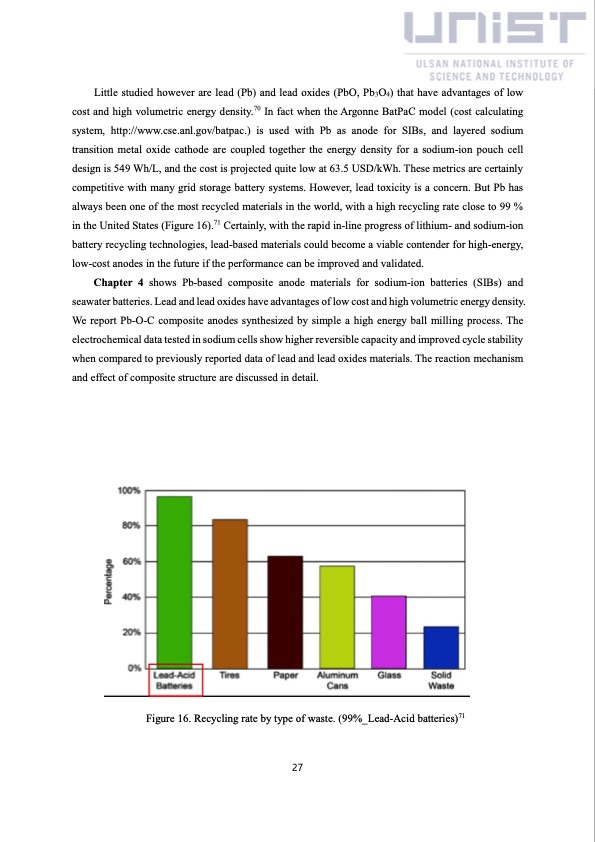
PDF Publication Title:
Text from PDF Page: 032
Little studied however are lead (Pb) and lead oxides (PbO, Pb3O4) that have advantages of low cost and high volumetric energy density.70 In fact when the Argonne BatPaC model (cost calculating system, http://www.cse.anl.gov/batpac.) is used with Pb as anode for SIBs, and layered sodium transition metal oxide cathode are coupled together the energy density for a sodium-ion pouch cell design is 549 Wh/L, and the cost is projected quite low at 63.5 USD/kWh. These metrics are certainly competitive with many grid storage battery systems. However, lead toxicity is a concern. But Pb has always been one of the most recycled materials in the world, with a high recycling rate close to 99 % in the United States (Figure 16).71 Certainly, with the rapid in-line progress of lithium- and sodium-ion battery recycling technologies, lead-based materials could become a viable contender for high-energy, low-cost anodes in the future if the performance can be improved and validated. Chapter 4 shows Pb-based composite anode materials for sodium-ion batteries (SIBs) and seawater batteries. Lead and lead oxides have advantages of low cost and high volumetric energy density. We report Pb-O-C composite anodes synthesized by simple a high energy ball milling process. The electrochemical data tested in sodium cells show higher reversible capacity and improved cycle stability when compared to previously reported data of lead and lead oxides materials. The reaction mechanism and effect of composite structure are discussed in detail. Figure 16. Recycling rate by type of waste. (99%_Lead-Acid batteries)71 27PDF Image | China solar seawater battery

PDF Search Title:
China solar seawater batteryOriginal File Name Searched:
solar-seawater.pdfDIY PDF Search: Google It | Yahoo | Bing
Product and Development Focus for Salgenx
Redox Flow Battery Technology: With the advent of the new USA tax credits for producing and selling batteries ($35/kW) we are focussing on a simple flow battery using shipping containers as the modular electrolyte storage units with tax credits up to $140,000 per system. Our main focus is on the salt battery. This battery can be used for both thermal and electrical storage applications. We call it the Cogeneration Battery or Cogen Battery. One project is converting salt (brine) based water conditioners to simultaneously produce power. In addition, there are many opportunities to extract Lithium from brine (salt lakes, groundwater, and producer water).Salt water or brine are huge sources for lithium. Most of the worlds lithium is acquired from a brine source. It's even in seawater in a low concentration. Brine is also a byproduct of huge powerplants, which can now use that as an electrolyte and a huge flow battery (which allows storage at the source).We welcome any business and equipment inquiries, as well as licensing our flow battery manufacturing.| CONTACT TEL: 608-238-6001 Email: greg@salgenx.com | RSS | AMP |